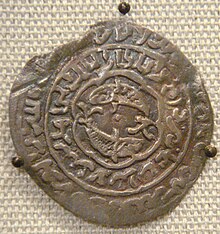Al-Ashraf Umar II
Umar Ibn Yussuf | |
|---|---|
 Coin of the Rasulids in 1335. | |
| Born | circa 1242 Yemen |
| Died | 22 November 1296 Yemen |
| Scientific career | |
| Fields | Astronomy, Mathematician and Physician |
Al‐Malik A‐Ashraf (Mumahhid Al‐Din) Umar Ibn Yūsuf Ibn Umar Ibn Alī Ibn Rasul (Arabic: عمر بن يوسف بن عمر بن علي بن رسول الغساني), also as Umar Ibn Yusuf (or also Al-Asharaf Umar II) was the third Rasulid sultan and also an Arab mathematician, astronomer and physician.
Biography

Umar Ibn Yusuf was born in 1242 in Yemen and he died in 1296. [2] He is known for writing the first description of the use of a magnetic compass for determining the qibla.[1] Also, his works on astronomy contain important information on earlier sources.[1]
In a treatise about astrolabes and sundials, al-Ashraf includes several paragraphs on the construction of a compass bowl (ṭāsa). He then uses the compass to determine the north point, the meridian (khaṭṭ niṣf al-nahār), and the Qibla towards Mecca. This is the first mention of a compass in a medieval Islamic scientific text and its earliest known use as a Qibla indicator, although al-Ashraf did not claim to be the first to use it for this purpose.[1]
Notes
- ^ a b c d Schmidl, Petra G. (1996–97). "Two Early Arabic Sources On The Magnetic Compass". Journal of Arabic and Islamic Studies. 1: 81–132.
{{cite journal}}: Invalid|ref=harv(help) http://www.uib.no/jais/v001ht/01-081-132schmidl1.htm#_ftn4 Archived 2014-09-02 at the Wayback Machine - ^ Schmidl 2007.
References
- Schmidl, Petra G. (2007). "Ashraf: al‐Malik al‐Ashraf (Mumahhid al‐Dīn) ʿUmar ibn Yūsuf ibn ʿUmar ibn ʿAlī ibn Rasūl". In Thomas Hockey; et al. (eds.). The Biographical Encyclopedia of Astronomers. New York: Springer. pp. 66–7. ISBN 9780387310220.
{{cite encyclopedia}}: Invalid|ref=harv(help) (PDF version)
